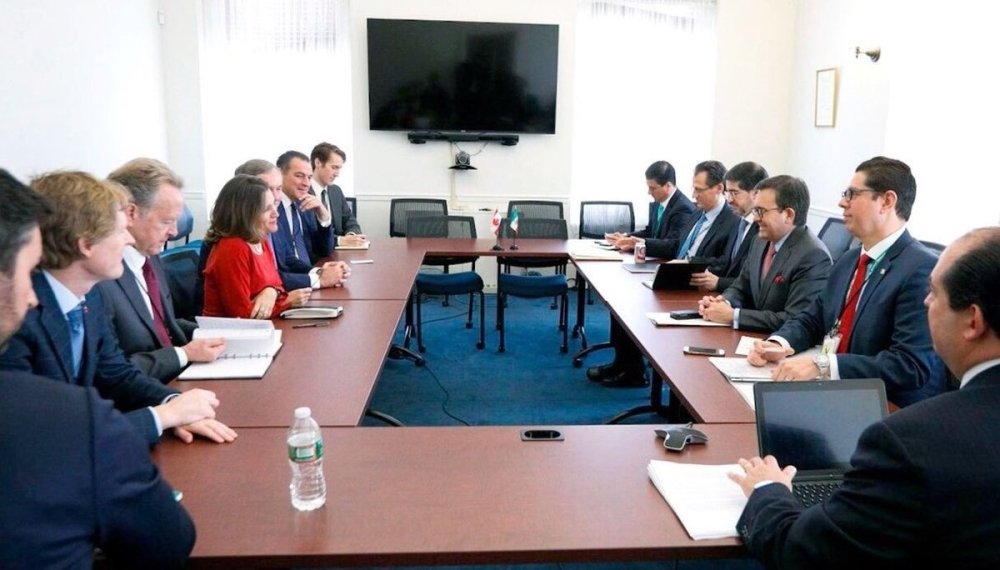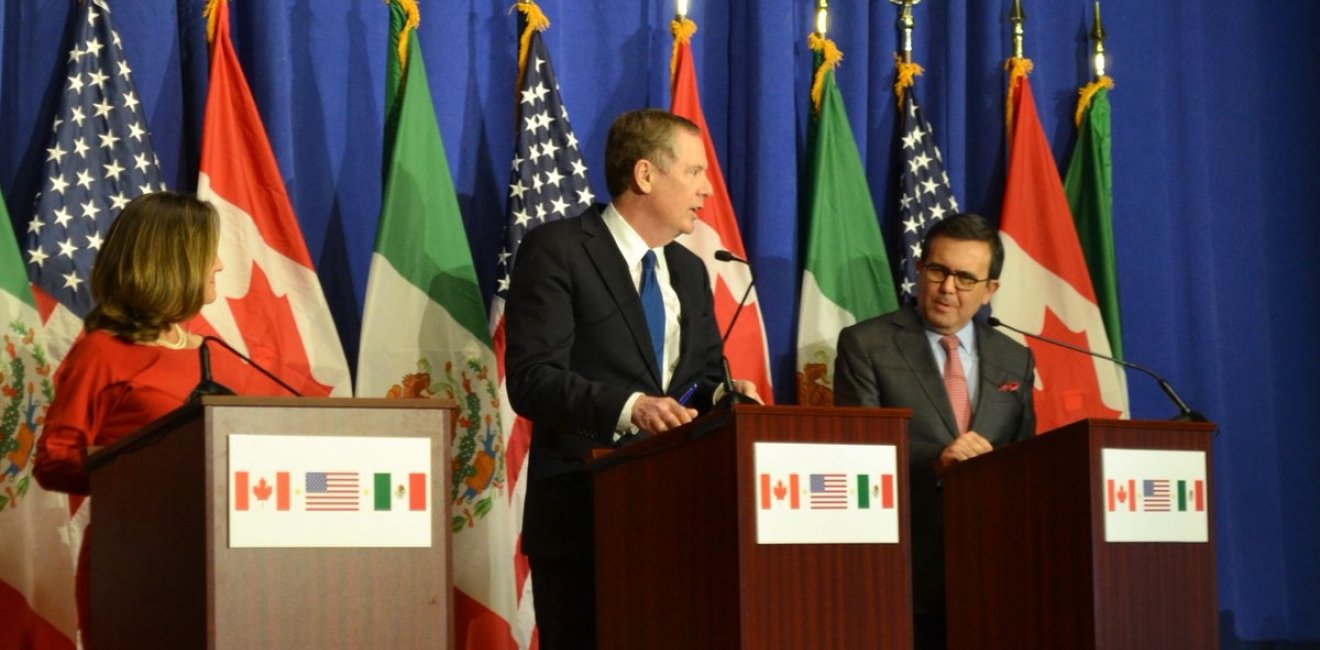Canada Will Stay at the Table Until NAFTA Becomes a Problem for the President and Congress to Solve
Canada walked away from the free trade negotiations with the United States in 1987. It did the same in 2016 in the negotiations with the European Union. Both walkouts were predicated on two assumptions. First, that the negotiations could go no further at the bureaucratic level and would have to be elevated to the political level for resolution, and secondly, the credible belief that the other side wanted a deal.
In the current NAFTA 2.0 negotiations, Canada and Mexico are under no illusions that the U.S. negotiators will call them back with a compromise if they walk. In fact, it is quite possible that the negotiators from the Office of the United States Trade Representative, who are part of the Executive Office of the President and take instructions directly from the President are under instructions to let the deal fail.
Mexico had originally said that they it would leave the table should the President trigger an Article 2205 notice to withdraw from the NAFTA. Now, sources close to the Mexican government say that Mexico is more likely to remain at the negotiating table for as long as possible.
Mexico and Canada, as well as a substantial share of U.S. industry and agriculture, have a modernization agenda they are seeking to achieve through this negotiation. In roughly 20 of 24 NAFTA issue areas, productive negotiations are progressing that follow a predictable model of offer and response, revise and compromise. Some of the easiest issues are those drawn from the Trans-Pacific Partnership text where all three NAFTA parties have already agreed to basic commitments in areas such as support for small business, expansion of digital services, and use of new technologies to facilitate customs clearance.
In some areas, movement is harder but still possible. These include labour mobility and dairy market access in Canada.
The real sticking points are the four so-called poison pills. These include reductions in government procurement access to such an extent that Bahrain, using WTO preferences, would have greater access to U.S. contracts than Canada does using NAFTA preferences; a sunset clause that would kill the deal on the basis of U.S. trade deficit triggers; automotive rules of origin that no North American automotive company could currently meet; and a dispute settlement system that allows participants to opt out at will. Wouldn’t your kids love it if you tried that at home?

Former PM Stephen Harper suggests that Canada devise compromise proposals that meet the U.S. administration half way on these deal killing initiatives. But, since the intention of these provisions is to kill the deal, a proposal that leaves the NAFTA “mostly dead” (to quote The Princess Bride’s Miracle Max) will not satisfy either anti-trade or pro-trade factions in the U.S.
My view is that the negotiators should focus on reaching a provisional settlement on issues where there is common ground and leave the job of rescuing the deal from a hostile administration to the U.S. Congress, where it belongs. Trade-oriented members of Congress have noted that the poison pills will equally harm U.S. production and investor confidence, and will provoke trade retaliation from Canada and Mexico.
But, leaders from the House Ways and Means and Senate Finance Committee have not yet seriously engaged on the trade file. Understandable when they are facing so many other legislative and governance challenges. With nearly 18 billion in U.S. agriculture exports to Mexico and 23 billion to Canada, Republican Senators from agricultural states are not going to let this agreement fail.
At present, there are enough pro-trade Republicans in Congress to preserve the NAFTA but the balance of power may shift after the November 2018 midterm elections. More Trump Republicans or anti-trade Democrats could skew the consensus away from the preserving NAFTA supply chains. If so, pro-trade factions in the United States will have to rely on court actions to try to suspend or delay presidential actions to remove the United States from the NAFTA.
Unfortunately, the least likely outcome is the near-term implementation of a modernized NAFTA that facilitates trade among the three countries. However, complete dissolution of the NAFTA is also unlikely. (The Wall Street Journal puts the odds at 1 in 4.) Most legal experts agree that it would be very difficult for the President to fully remove the U.S. from NAFTA without Congress and there is little support for this action among U.S. legislators.
The more likely scenarios are that the President launches a notice of withdrawal that is blocked for the next couple of years by the legislative or judicial branch. Pro-trade organizations are preparing to launch legal actions to halt or slow down a Presidential action. At the legislative level, Congress, using Trade Promotion Authority, has the authority to accept or reject a finished deal and to be consulted during the negotiations. Thus, the main legislative influence takes place at the end of the negotiations but, through its mandated consultations, Congress can let the USTR know that it will not support a deal that disrupts supply chains, deflects foreign investment and provokes foreign retaliation.
In practical terms, the most likely short-term option is a zombie NAFTA that is neither alive nor dead while North American producers and consumers wait for a presidential change of heart or a change of president. The zombie option is preferable to a completely dead NAFTA, but the economic effects of such instability are undeniably negative for all three countries.
More than 80 percent of economists surveyed by the Wall Street Journal this month predict that a NAFTA withdrawal would hurt U.S. growth, some predicting it could even trigger a recession. But it is not necessary to kill the deal to torpedo the U.S. economy. In a letter to Commerce Secretary Wilbur Ross, more than 80 U.S. agricultural groups said they were "sadly confident" that even the initiation of withdrawal measures would trigger cancellation of commodity order and product-specific retaliation. Once such supply chains are broken, these markets are not easily restored.
It is by no means certain that the NAFTA will fail, but what is clear is that the resolution of the issue lies in U.S. political hands. Facing this reality, Canadian negotiators should continue to work on the issues where they can make a difference until they can go no further, recognizing that once they the leave the table, influence over final outcomes moves out of Canadian control.
Author

Executive Director, Future Borders Coalition

Canada Institute
The mission of the Wilson Center's Canada Institute is to raise the level of knowledge of Canada in the United States, particularly within the Washington, DC policy community. Research projects, initiatives, podcasts, and publications cover contemporary Canada, US-Canadian relations, North American political economy, and Canada's global role as it intersects with US national interests. Read more


Mexico Institute
The Mexico Institute seeks to improve understanding, communication, and cooperation between Mexico and the United States by promoting original research, encouraging public discussion, and proposing policy options for enhancing the bilateral relationship. A binational Advisory Board, chaired by Luis Téllez and Earl Anthony Wayne, oversees the work of the Mexico Institute. Read more





